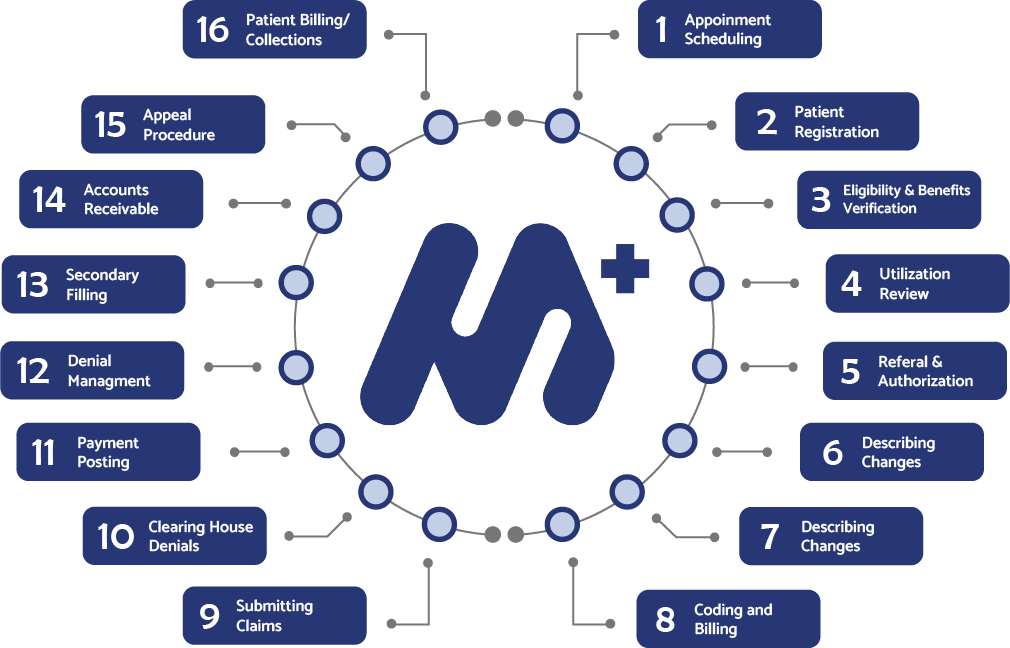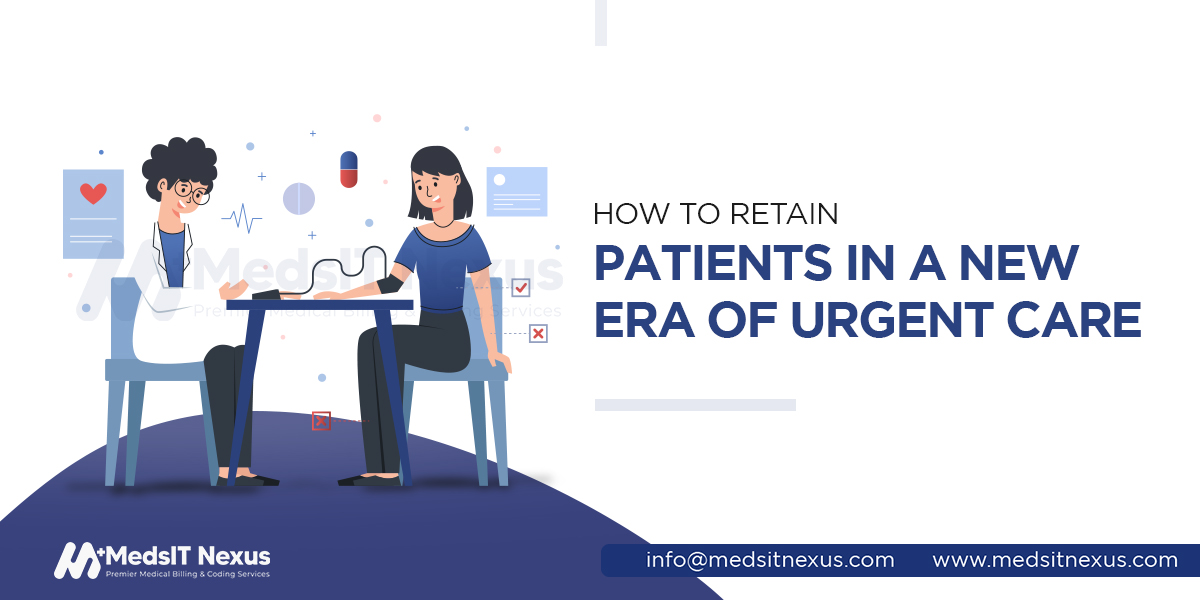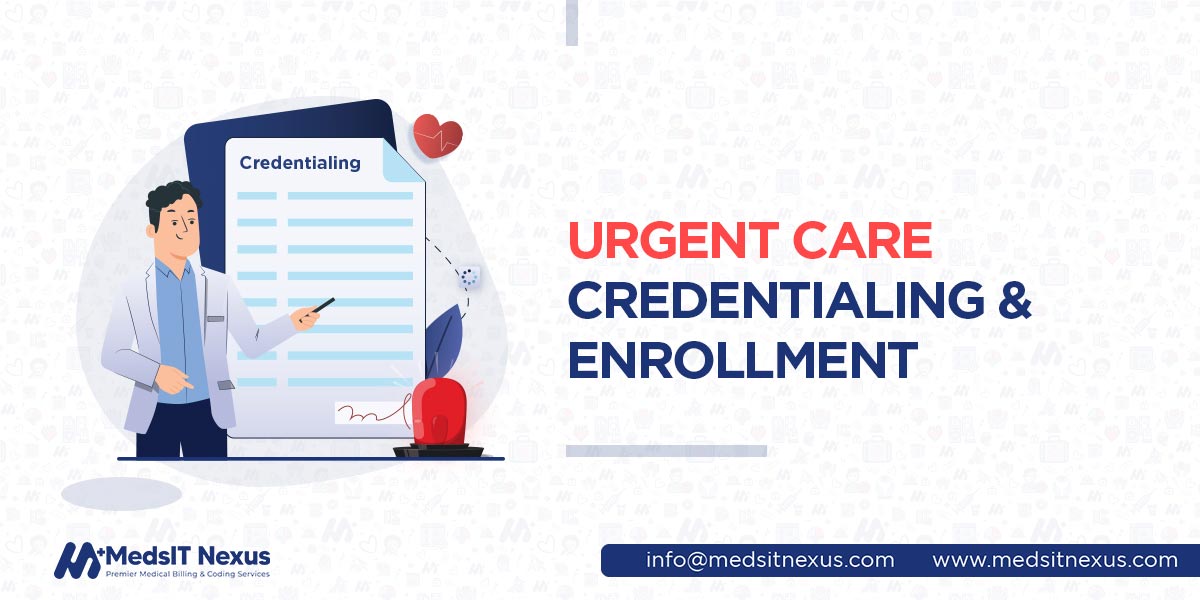Urgent care billing – Comprehensive Medicare Guidelines 2024

As per the critical requirement initiated by the healthcare regulatory bodies in the USA, medical
providers, and healthcare practitioners would only get reimbursement for their services if they follow a
value-based healthcare model in their practice revenue cycle management — a patient-centric approach in
providing healthcare services to their patients. As per the insurance compliance requirements regarding
the fee-for-service, your practice is financially dependent on the healthcare outcomes, including
improving the patient’s health and minimizing the effects and incidence of chronic disease against the
cost of delivering the outcomes. No matter how much volume of patients you serve in your organization,
minimum negligence regarding value-based reimbursement in your urgent care billing workflow processes
would make you a victim of Federal compliance and thus overwhelm your practice under legislative
penalties.
outsource medical billing to a renowned healthcare administrative partner will remain beneficial as it
overcomes most of the legislative complications of the processes.
Having said that, Introducing MedsIT Nexus, your trusted USA-based group of urgent care billing
specialists whose certified professionals are excel in handling crucial insurance collection cases, with
a specific focus on common urgent care procedures. Our comprehensive and tailored solutions for
healthcare providers, ensures accuracy and compliance in every aspect of the billing process. Led by a
dedicated RCM solution manager, our team stays ahead with the latest updates, particularly the CMS/AMA
general E&M Coding guidelines, providing insightful guidance for accurate urgent care claims filing.
Choosing MedsIT Nexus for efficient, compliant, and expert urgent care billing services would be highly
beneficial as we prioritize your success by navigating the complexities of insurance claims, allowing
you to concentrate on delivering quality patient care with confidence. In this particular guide our
experts aim to provide almost every possible query most commonly asked by our clients – urgent care
providers. Therefore, following it will definitely help you find the solutions for everyday scenarios
that take place in the immediate care billing departments.
Enhancing Urgent Care Revenue Cycle Management: Streamlining Insurance Collection Workflow with MedsIT Nexus
Before we move forward to the urgent care coding guidelines, here is an overview of our RCM; it is
critical to know that your practice must adopt a healthy practice revenue management to get maximum
reimbursement from your Payor with minimum denials. We at MedsIT Nexus serve our clients with scalable
provider enrollment & credentialing services tailored to the urgent care specialty within RCM, which is
the backbone of the process. The process starts right from appointment scheduling and continues with
patient registration, EOB validation, coding and billing, claim submission, adjudication, and denial
process and ends on the final step, which is patient billing and collection. Our process strictly
adheres to urgent care compliance, ensuring that our contracted practice experiences a maximum cash flow
for its rendered services. Follow the official infographic mentioned below for a better understanding of
the Credentialing enrollment and RCM process.

Comprehensive Guide to CMS/AMA Urgent Care Billing: Decoding Pos-20 & E/M CPT Codes for Optimal Reimbursement
As dictated by the CMS/AMA formal coding regulations, it is imperative that urgent care claims processed
post-June 1, 2022, adhere to billing specifications, utilizing POS 20 with a corresponding level of
service provided to the member. This specific code has evolved into a pivotal requirement for
successfully filing a claim with the Payor through Medicare because of the reason medical practitioners
strategically employ S codes to maximize billing for their services, particularly after regular
treatment hours when the costs associated with rendered services are heightened.
POS 20 is a place of service code that is used to indicate that the patient is treated or diagnosed for
the illness or injury for unscheduled ambulatory patients that were seeking immediate medical attention
within urgent care facility rather than emergency room more precisely. However, the claims are still
processed with the codes POS-10 or POS-11 where the location is still a primary care office that is
distinct to the hospital, skilled nursing facility (SNF), military treatment facility, community health
center, State or local public health clinic, or intermediate care facility (ICF) where the medical
providers perform their routine services health examinations, diagnosis, and treatment of disease or
injury on a ambulatory basis. In the given context, it is critical to understand that Medicare will
reimburse for the urgent care provided services while it might raise the objection on the claims that
consist of the naturally expensive walk-in procedures; if so – to increase practices revenue medical
providers are required to maximise the amount of privately insured patients.
Most commonly used urgent care codes — CPT & HCPCS codes
There is a significant similarity between the medical procedures and conditions in the primary care
office and the urgent care facility. Urgent care and primary care services are correlated; therefore,
the medical insurance legislative consultants recommend creating an identical entity to avoid
anti-kickback laws such as a Stark law, which governs medical providers for the Medicare patient's
referrals for services that benefit them financially.
In this context, “S codes” must be used as per the CMS billing guidelines, identifying the type and
level of service provided to the patients in urgent care settings with an indication that the visit is
worth extra compensation over the primary care visits. Moreover, the providers are also required to bill
the urgent care services under a separate taxpayer identification number to keep them distinct from the
primary care services.
S codes are the critical component of the Healthcare Common Procedure Coding System (HCPCS) in Urgent
Care billing where these codes are billed along with relevant Evaluation and Management CPT codes (99201
- 99215) from the CPT manual's office or other outpatient services section. This integration ensures
comprehensive documentation and accurate billing practices, optimizing reimbursement for urgent care
services.
Along with it, appropriate modifiers are also required to add with codes for any procedures performed
during the visit. There are two commonly used S codes, S9088 and S9083, in the urgent care facility, and
here in this section, we are going to cover the broad aspect of this particular coding system, such as
the reimbursement, procedure code medicare description and CMS billing guidelines, so on and forth.
Exclusive “S” Codes for Urgent Care Billing Departments — Comprehensive difference between S9083 & S9088
Medical billing codes that are specific to the urgent care centers begin with the letter “S”. This is an
identifier that these codes are not billable to government Payors such as Medicaid & Medicare instead,
private insurers and agencies (including managed care organizations [MCOs] and state workers
compensation boards) might pay for them – using these codes helpful in defining specific services that
are neither recognized nor reimbursed by Medicare or Medicaid. This is because Medicare has no special
rules for urgent care and is considered equal to any other outpatient physician office.
Also, there are other than mentioned “S” billing codes, such as 99050 and 99053, which are for
urgent-care patient visits outside office hours, and 99051 is for providing extended hours services such
as on evenings, weekends, and holidays — including Christmas and New Year's Day. Here, we would solely
focus on discussing the commonly used S9083 and S9088 code descriptions, the reimbursement, the core
difference, and the conceptual gap between them.
When billing with an S9083, the reimbursement by the Payors would be based on a flat rate methodology –
a global fee for service that allows urgent care to combine the services and other procedures performed
on the same day in an urgent care center without distinguishing between the procedures of a hangnail or
a heart attack. Conversely, when the claim is filed with the S9088, the insurer uses this particular
code to identify the services rendered within the urgent care center instead of the traditional primary
care physician offices — which significantly cost more because of the unscheduled walk-in visits during
all open hours and offering significantly extended hours, which may include evenings, weekends, and
holidays. Thus, this particular code is used as an “add-on” code to reimburse the urgent care centers
with the increased cost of rendering service
2024 Updated Urgent Care Evaluation & Management CPT Codes
As per the health insurer legislative regulations, such as CMS, services rendered in urgent care centers
must be billed based on the level of service provided to the member, which is determined by reporting
applicable evaluation and management (E&M) codes.
These E/M CPT codes are broadly categorized into the NewPatient & EstablishedPatient CPT codes. Claims
submitted for these office visit code family are analyzed against the following information mentioned
below in an Urgent Care Comparative Billing Report (CBR) — it is one of the many other tools used in
billing and coding audits for the primary purpose of assisting individual providers to become proactive
in addressing potential billing issues and performing internal audits ensuring compliance with Medicare
guidelines
Note:
The Centers for Medicare and Medicaid Services sought clarifications on the reporting of evaluation and
management (E/M) services, prompting revisions to the CPT 2024 code set. These revisions include the
removal of time ranges from office or other outpatient visit codes (99202-99205, 99212-99215) and
alignment of the format with other E/M codes
| CPT Code | Level of Severity | Criteria, Time Spent, and Key Components |
| 99211 | Problems are minor | This particular e/m code represents a situation where treatment or the required medical procedure to be performed does not require a physician or qualified medical professional level of care. In case there does a need for a physician, the situation of a patient would be a minor one that needs to be handled on a minor complexity and will remain self-limited, where the decision-making would remain straightforward and typically requires a 5 minutes to perform or supervise as per the official timing based coding guidelines. |
| 99212 | Straightforward | This particular E/M (Evaluation and Management) code pertains to an office or other outpatient visit for the evaluation and management of an established patient. In this context, the patient's problem-focused medical history and/or examination must be medically appropriate. The medical decision-making associated with this code is typically straightforward. However, when determining the code based on time, it's important to note that a minimum of 10 minutes must be met or exceeded face-to-face with the patient and/or family. |
| 99213 | Low | Office or another outpatient visit for the evaluation and management of an established patient, which requires a medically appropriate history and/or examination and a low level of medical decision-making with a limited complexity. When using time for code selection, 20 minutes must be met or exceeded. |
| 99214 | Moderate | Presenting problems/services that require a physician or other qualified health care professional licensure and are of moderate or high complexity with the following critical components requiring moderate to high medical decision-making with a detailed examination and a detailed medically appropriate history. |
| 99215 | High | Office or other outpatient visits for the evaluation and management of an established patient, which requires a medically appropriate, comprehensive history and/or examination and a high level of complexity in medical decision-making. When using time for code selection, 40 minutes must be met or exceeded |
| CPT Code | Level of Severity | Criteria, Time Spent, and Key Components |
| 99202 | Straight forward | Office or another outpatient visit for the evaluation and management of a new patient, that may or may not require a physician or other qualified health care professional. If the presentation requires a physician level of care, it is a self-limited or minor problem requiring straightforward decision-making and is minimal complex. When using time for code selection, 15 minutes must be met or exceeded. |
| 99203 | Low | This particular code presents the problems and services that require a physician or any other qualified, credentialed medical provider to take over the case of limited complexity, requiring a low level of decision-making. As far as the time for the evaluation is considered, 30-44 minutes must be met or exceeded |
| 99204 | Moderate | This particular em code in the medical coding documentation makes Payor identify the presentation of the problems and services requiring the qualified, licensure, and credentialed medical provider for the moderate or high level of complexity in the medical decision making process |
| 99205 | High | This code has a same description as of the 99204 with a difference of the no of minutes spent which is a 60 minutes in presenting problems and services in a high level of the complexity of making a medical decision |
Outsource your Urgent Care Billing needs to MedsIT Nexus – 10 X cost efficiency of your revenue cycle process with our automation
Outsourcing and automation are the two concepts that are strategically connected to the efficiency of
your urgent care revenue cycle processes. The multistep processes and the required software licensing
and other expenses resulting in the high cost of collection for the small practices, which is a critical
KPI that urgent care facilities use to track the expenses that are involved in their patient financial
services.
These expenses may include the patient billing, including employee wages, office facility overhead, and
even the cost of paper for invoices, and it must be optimized for a healthy and more efficient revenue
cycle, which means the cost must be maintained at the lowest threshold in a complete cycle which results
in the healthier margins and better financial performance. Finding ways to lower this particular cost is
an ongoing challenge, and this is where the MedsIT Nexus revenue cycle outsourcing comes into play that
automates the processes by using urgent care EHR technology and a dedicated, proficient workforce to
handle the repetitive and time-consuming tasks, significantly cutting down the cost of production and
boost efficiency in your patient care delivery that assists your practice in adopting the value-based
reimbursement model ultimately boost practice’s revenue with the optimized insurance collection
rate.
Dr. Sana Pervez, Pharm.D, CCS, CPC -
Clinical Compliance Advisor at MedsIT Nexus
Responsible for Medical and compliance review of all healthcare RCM and billing content before publication.
Other Editors
Samuel White - Marshall-Russ -Related Posts

How to retain patients in a new era of urgent care?





